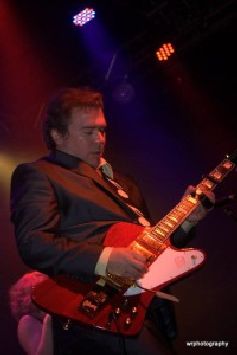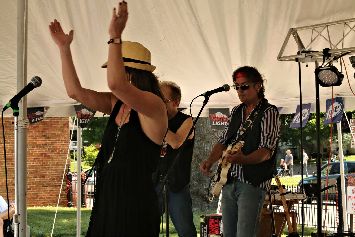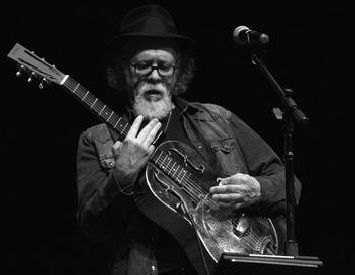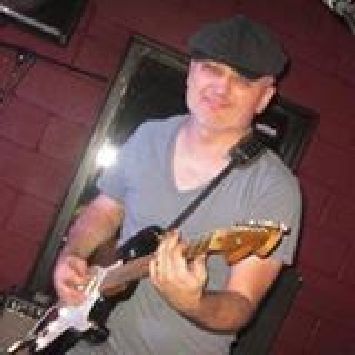social bookmarking tools:
 |
|
| Available RSS Feeds |
|---|
 - Top Picks - Top Picks |
 - Today's Music - Today's Music |
 - Editor's Blog - Editor's Blog
|
 - Articles - Articles
|
Add Louisville Music News' RSS Feed to Your Yahoo!
|
I've Got A Mind To Ramble
Welcome to the first installment of "Slide guitar: What the Hawaiian kid discovered – or did he?"
While this is obviously supposed to have a local (and blues) focus (and it eventually will), it's necessary to provide some background.
When the phrase "slide guitar" is mentioned, audio "images" come to mind, and perhaps names pop into your head: Elmore James, Hound Dog Taylor, Robert Johnson, Duane Allman…
But, does anyone know where this style of playing guitar came from and when? After some research, I discovered the answer is "not really." However, a few stories do seem to surface more often than others. One is that the technique of using a slide on a string has been traced to one-stringed African instruments, similar to what's been called a "Diddley bow." The technique was made popular by African American blues musicians.
Here's where the initial local connection can be made; because the first musician to be recorded using that style was Sylvester Weaver, who recorded two sides: "Guitar Rag" and "Guitar Blues" in the early 1920s. Others followed: Blind Willie Johnson, Blind Willie McTell, Mississippi Fred McDowell, the aforementioned Robert Johnson and Son House, to name a few.
It was Elmore James who likely became the first influential classic electric blues slide guitarist. In the early 1950s, he created a slide guitar interpretation of Johnson's 1936 tune "Dust My Broom," which has arguably become one of the most popular and widely played riffs in blues music history.
Now, let's go backwards a bit for the "other" popular slide guitar origin story:
Hawaiian music certainly has the slide guitar sound, and a teenager can be credited with giving it a popularity boost for the rest of the world. Joseph Kekuku (1874-1932) was walking along a railroad track with his guitar one day and found an old metal screw or bolt. The story goes that he accidentally (some versions say he did it on purpose to see what it would sound like) dragged the item along a string, thought it interesting and eventually recorded some music using a slide technique (It is not clear what material he used for a slide when he made the actual recording). This allegedly helped popularize the sound in the mainland US and gave more impetus to the already established African American style.
The guitar makers, the evolution of the slide guitar style, the explanation of the technique of how to play, the musicians who would go on to perpetuate slide guitar – all that could take an entire article. Readers here might be already familiar with all that; maybe what you've read here is "old news." After all, blues music and slide guitar have gone hand-in-hand for many decades.
So, let's fast forward many more decades from Sylvester Weaver and talk with some of the guys who like to play slide guitar here in Louisville.
CORT DUGGINS:
Cort Duggins has been playing guitar most of his life, and is currently the guitarist for Laurie Jane and the 45s.
Duggins' dad was a key influence for him musically, and he says that as a child in the early 1980s, he was watching MTV with his dad and saw George Thorogood's video "Bad to the Bone." The elder Duggins picked up an old Bic lighter and played the main riff.

Needless to say, the young man was smitten and tried – with the help of his dad – playing slide with all sorts of items: aspirin bottles, lighters, and sockets. He also seems a bit reluctant to admit, but admit he does, that the movie "Crossroads" with Ralph Macchio "set me on fire" with regard to slide guitar. His dad even got him a small Pignose amplifier, which he has to this day. He would walk up and down the street playing slide guitar for the other kids.
Duggins says the history, fabrication and artistry of the slide itself captures his imagination as much as the sounds produced by that technique. He says it holds a "primal fascination" to make his own slides from wine bottle necks. For the slides he purchases commercially, however, he prefers custom-made Doc Sigmier slides from Rocky Mountain Slides. All told, he reports having more than 100 slides in total.
Names from his influences include Jimmy Page, Eric Clapton, Elmore James, Mike Bloomfield, Hound Dog Taylor, Lil' Ed, and Roy Rogers.
Duggins says he uses a slide around half the time whether on record or live. "This is magic! There is a factor to it that is beyond my control," he says.
"Between the slide and my resonant and often over-amplified guitar, there are often notes that I did not intentionally play. Those notes are occasionally beautiful and are always full of mystery and wonder for me."
JIMMY DAVIS:
Jimmy Davis, of Madison, Indiana, who, like many budding guitarists, first heard slide guitar played by Duane Allman on the album Live at the Fillmore. He remembers that it sounded like a human voice. That got him listening to older slide stuff, like music by Elmore James.
One of the first tunes he ever played with a slide was "Walkin' Blues," and he stayed with mostly open-tuning since then because he found it easier than playing slide in standard tuning. However, he admits to challenging himself more in recent years by playing it more in standard.
Davis says he is mostly self-taught with regard to the slide. "I lifted stuff from records. I didn't have any slide players to study with."
His main influences, for the most part, are Elmore James, Duane Allman, Hound Dog Taylor, Son House… "I still dig 'em," he says. "Those guys, the imperfect players, it's the rawness, the lack of polish, that I like. It's hard to polish that kind of style and attitude."
Davis also admires Sonny Landreth for his technique, and, ironically, for his polished and professional skill. "But that's not what it's about for me," he says.
He plays more slide in his solo sets than he does with his band. His solo slide stuff seems to get people's attention the most, according to Davis. "I do some cigar box, some Dobro stuff. People dig the primal blues."
Davis' main instruments for acoustic work are a custom-made Zeiler, made by a Rising Sun, Indiana, luthier, and a Martin. For electric work, it's usually a "Tele" of some type, or hollow body. And he always uses metal slides – perhaps for that raw, unpolished sound he likes so much.
TONY TKAC:
Mostly known for his work with Little T&A, Tkac has made a name for himself playing Rolling Stones-based rock and blues and other tunes with the band – and, playing slide guitar.
His venture into slide began with an "acetate" disc, an instructional disc he obtained when he was 15 years old. Tkac thinks the instructor was Arlen Roth. It was on this disc he was introduced to what he simply calls "the lick," that staccato intro to the famous "Dust My Broom". He didn't know Elmore James, or what the blues was about, at that time. "Heck, I barely knew how to make chords, but I sure knew that lick," he says. He would eventually go on to incorporate that intro into songs when he was in bands and did learn about Elmore James, and others.

Tkac notes that he never had any slide guitar lessons (he recalls that a blind man taught him open E tuning), and by the time he really wanted to and could take lessons, the people he wanted to learn from were no longer teaching.
Another memorable experience was when he was in his early twenties as the sound man and artist transport person at a St. Matthews club known as Stompanados. He met John Hammond, Jr., back then. Tkac recalls that Hammond had a nice guitar. Hammond asked Tkac if he could play, to which the answer was "Well, I dabble."
"Do you play slide? Hammond queried "Well, I play this," and Tkac ripped into his favorite lick. Hammond seemed impressed, and said "You do more than just dabble." Again, Tkac was meeting and hearing an artist who he would only years later come to appreciate and know.
Tkac's days of being in bands had taken off as he began figuring out the blues, yet he didn't play slide until the 1980s and even then, just a little. He held off playing it much at all until about five years ago as he was getting back into the playing scene. He recalls not seeing many guys playing that style.
Although Tkac's percentage of slide to non-slide playing is still relatively low, he has taken on a greater appreciation and has honed his technique. And yes, he still throws in that "Dust My Broom" lick whenever it seems appropriate.
Tkac truly enjoys the roots-driven, earthy sound of slide guitar and currently utilizes the open G tuning a lot when he plays it., usually with a heavy brass slide on his middle finger. While that isn't the way the majority of slide players do it, he's found a way to make it work.
He cites Ron Wood of the Stones, Elmore James (for his favorite slide lick), Taj Mahal, the late Lowell George, Duane Allman, Jerry Douglas, Ry Cooder and locals John Burgard and Mark Hoekstra as some of his favorite players.
COLE STEVENS:
Cole Prior Stevens, originally from Bakersfield, California, lived in Louisville for a few years before his wife passed away. He currently resides in Virginia. Stevens made an impact and impression on the folks here in the 'Ville, so he was afforded the opportunity to share his experiences and insights into slide guitar for this article.

Stevens says he was probably 10 years old when he first heard the sound, from other people's records. It was when he was in his teen years that he discovered just what was making the sound. It had a huge impact on him musically, because it was unlike anything he had heard before.
Stevens began playing slide guitar in the late 1960s, got poor results compared to what he was hearing on recordings, had no idea what he was doing and abandoned the technique for perhaps 20 years.
At first, Stevens taught himself, mostly trying to emulate Duane Allman licks in standard tuning and still getting poor results for the same aforementioned reasons.
Discovering open tunings, the pre-war slide masters (such as Son House, muddy Waters and Tampa Red), and later instructional videos (such as those from Bob Brozman) helped Stevens become a slide player. Even still, it was a "hit and miss" kind of approach for him.
Stevens eventually became good enough, and comfortable enough, to incorporate slide into his music as much as 50-75% of the time in his current shows. He even considers himself to be above average now.
Besides the previously mentioned musicians, one of his favorites is Paul Black, who plays electric open-tuning slide style. Stevens says Black is "a very scary, unpredictable and emotionally deeply connected slide player – the real deal." Unfortunately, Stevens reports that Black has become terminally ill and has stopped performing.
Currently, Stevens plays mostly in open D tuning on Fender telecasters for his electric shows and uses three different National Resophonic instruments for acoustic material. Over the last fifteen years, Stevens has used mostly glass slides from the UK, particularly Diamond bottleneck slides.
JIMMY GAETANO:
Gaetano, who owns Jimmy's Music Center in New Albany, is from Texas, so it is no surprise when he says his first memory of hearing slide guitar was ZZ Top's Billy Gibbons' solo for the song "Tush." That was what drew him to the slide guitar.
In the late 1980s, Gaetano attended music school and as luck would have it, the guitar department head was a blues musician and an excellent slide player. All his questions were answered.

Reflecting his rather thorough education, Gaetano talks in easy to understand, yet musically educational, terms, in order to explain slide guitar.
Gaetano explains what he knows about the history of slide guitar, mentions the one-string diddly bow and offers possible reasons for this simple creation: a single string (wire) attached to, or stretched across, a surface or opening, held in place on two ends by nails. Various items were used to actually create melodies. Thus, slide playing was born. (This would be the very, very short version of the story.)
More modern stringed instruments are now associated with slide playing, as well as more music genres. However, Gaetano's genre of choice is blues, so he spends time absorbing what the original bluesmen have done. His two current favorites are Muddy Waters and Elmore James. Waters played in standard tuning and used a capo for different keys. James played mostly in open D (DADF#AD). Gaetano notes various reasons the style of each appeals to him and describes their techniques, making it plain he understands the technical aspects of guitar and, more specifically, slide playing.
Gaetano is not without facing challenges, though – his biggest being intonation (or playing in tune) when playing slide, and not overplaying. He maintains that "blues is simple, but yet difficult at the same time." He says he only plays slide when needed for the song, and maybe for only a couple of songs during several sets during a night of music.
He reports that he prefers using a brass slide for a brighter sound, a glass or Pyrex one for a warmer tone. He prefers a Gibson SG, as do some of the most accomplished slide players, for playing slide guitar.
Gaetano says he tries to avoid effects, and maintains that a Fender amp's natural overdrive creates the best tone and sustain.
NOTE: For various reasons, not everyone I wanted to interview was able to be included in the article. This is also obviously not a comprehensive list of everyone who plays slide guitar in Louisville. Next month, Part II will perhaps (if things work out) include the other persons I had planned on interviewing. Also, it will ask the question "Where are the slide-playing women?" Whether or not that can be definitively answered remains to be seen.
